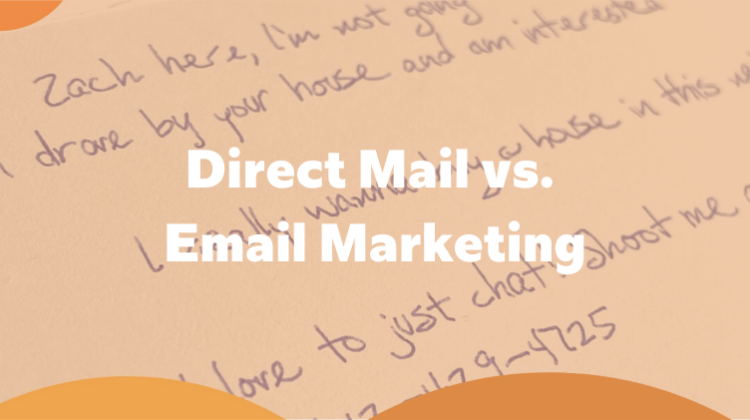
Direct Mail vs. Email Marketing
Digital marketing experts estimate that most Americans are exposed to 4,000 to 10,000 ads each day. With so many messages fighting for our attention, businesses need to find a way to stand out.
So, when it comes to direct mail vs email marketing, which works best for getting noticed? Both can be powerful tools for reaching customers, but they work in different ways. Understanding email vs direct mail will help you decide where to focus your time and money.
In this article, we’ll break down direct mail marketing vs email marketing, their pros and cons, and which option can deliver the best results for your business.
And if you want to get started with a handwritten direct mail marketing campaign for your business, contact us today to learn more and get 200 letters free.
What is the Difference Between Email and Direct Mail?
The main difference between direct mail and email marketing is how your message is delivered.
Email marketing uses email to communicate with current and potential customers. Common examples include newsletters, welcome sequences, and promotional campaigns.
Direct mail marketing is when a company sends a physical item to its current and potential customers. This could be something as simple as a postcard or as personal as a handwritten note. There are two main types:
- Printed direct mail: mass-printed marketing materials such as brochures, flyers, catalogs, or coupons.
- Handwritten direct mail: personalized handwritten letters that feel more personal, such as thank-you cards, donor acknowledgments, and follow-ups
Both have strengths and weaknesses, so when it comes to email vs. direct mail, the best choice depends on your business goals.
Email Marketing Advantages & Disadvantages
Email marketing’s main advantages are its speed, scalability, and cost-effectiveness. With email marketing, businesses can send messages to their current and potential clients in minutes at a relatively low cost.
The downside is that engagement on email marketing campaigns is typically very low. Roughly 40% of email users have at least 50 unread messages, not including emails that go to spam.
Plus, even when emails are personalized, today’s customers are smart enough to know they’re mass-produced and automated, which leads to lower engagement. On average, email open rates are about 21.5%, with response rates of 2.8% for B2C and 2.4% for B2B marketing. Stats show the majority of email marketing goes unopened and unread.
When comparing email marketing vs. direct mail, email is best for speed, automation, and affordability. However, when it comes to engagement, direct mail has the advantage.
Direct Mail Advantages & Disadvantages
The biggest advantage of direct mail is that it stands out, especially when it’s handwritten. Think about the last time you received a handwritten note compared to the last marketing email you opened. Handwritten mail is uncommon, which makes it memorable. Handwritten mail also feels more authentic, which makes customers more likely to take action.
When you look at direct mail vs email statistics, the impact of handwritten notes becomes clear. On average, printed direct mail earns a 91% open rate and a 3.63% response rate, both far higher than email. Handwritten direct mail performs even better, with open rates reaching 99%.
When it comes to direct mail vs email response rates, direct mail is the obvious choice.
That said, direct mail has its drawbacks. The biggest is cost. Printed pieces like postcards and flyers are more expensive than email and can still feel generic and impersonal.
Handwritten mail solves that problem by creating a genuine connection. And thanks to new technologies that make handwritten mail easier to create, costs are much lower than in the past, and handwritten direct mail is much more cost-effective thanks to higher open and engagement rates.
Direct Mail vs Email Marketing: Which is Best?
Both marketing channels have their advantages, but if you’re comparing email marketing vs direct mail stats and your goal is to get in front of people and increase conversions and ROI, direct mail is the winner, especially when it’s handwritten.
It’s clear that direct mail marketing is effective, but the challenge with handwritten direct mail has always been cost and scalability. The good news is, Scribe found a way to solve these problems.
How Scribe Helps You Stand Out for Less
The problem with direct mail has never been its effectiveness, but rather the time and cost that it requires. Luckily, Scribe solves that with AI-powered handwriting robots that create and mail authentic handwritten cards for you. You get all the personal connection, without the manual work. And at $1.69–$3.49 per card, Scribe costs far less than competitors, charging $2.95–$8.95.
Plus, Scribe integrates with your CRM and marketing workflows, so you can set up handwritten notes to be mailed automatically based on customer actions such as renewals, birthdays, or follow-ups.
With Scribe, you get the benefits of sending personal, handwritten letters without the time, cost, and effort of doing it manually. With Scribe’s automation, it’s never been easier or more affordable to use handwritten direct mail in your business.
See how handwritten direct mail can improve your business outreach and ROI. Contact us to try Scribe today and get 200 letters free.
